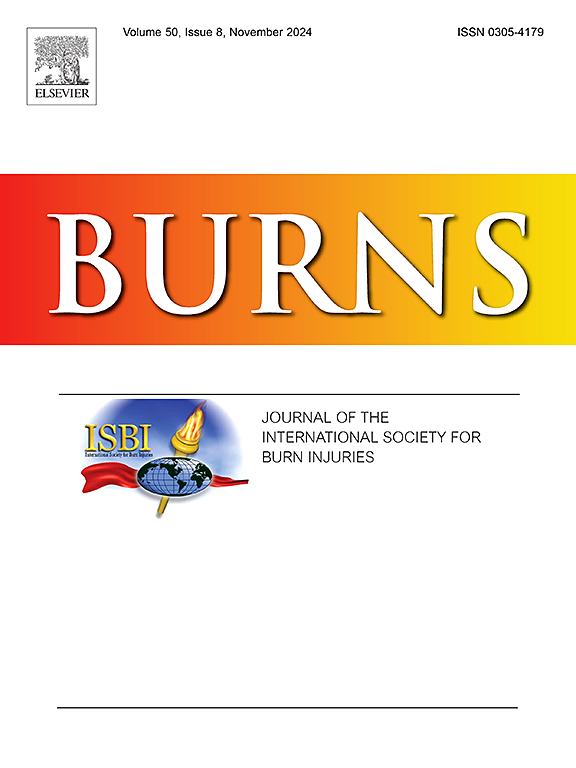Randomized, controlled, within-patient, single-blinded pilot study to evaluate the efficacy of 12-weeks of endermotherapy with adult burn survivors
IF 3.2
3区 医学
Q2 CRITICAL CARE MEDICINE
引用次数: 0
Abstract
Background
Vacuum massage, or endermotherapy, is applied to scar tissue with the primary therapeutic goal of promoting structural or physiological changes. These changes are intended to enhance pliability, enabling the skin to possess the strength and elasticity required for normal mobility. The advantage of vacuum massage compared to therapist-generated manual massage is that it provides a standardized dosage using rollers and suction valves to mobilize the tissue. However, research documenting and supporting its impact on post-burn hypertrophic scar is lacking. Thus, this study was designed to objectively characterize the changes in scar elasticity, erythema, melanin, thickness, and transepidermal water loss immediately after a vacuum massage session and after a 12-week course of treatment compared to intra-individual matched control scars.
Methods
We conducted a prospective, randomized, controlled, within-patient, single-blinded clinical trial, initially designed as a fully-powered study but limited to a pilot study due to COVID-19 restrictions. Nineteen burn survivors consented to participate and 16 completed the study. Two homogeneous, intra-individual scars were randomized to usual care control or vacuum massage therapy plus usual care. Vacuum massage interventions were provided by a certified massage therapist three times per week for 12 weeks. Scar characteristics were evaluated every four weeks immediately before and after mechanical massage treatment. The evaluations included measurements of elasticity (Cutometer), erythema and melanin (Mexameter), transepidermal water loss (TEWL) (Tewameter), and thickness (high-frequency ultrasound). Linear mixed-model analyses were performed to test for immediate and long-term treatment effects.
Results
The ANOVA analyses revealed a non-significant time:treatment interaction for elasticity, erythema, melanin, thickness, or TEWL. There was a significant increase in elasticity and erythema and a decrease in TEWL in both the control and treatment sites over time with consistent standard care. However, there was no statistically significant immediate or long-term treatment effect for any of the skin characteristics. Nonetheless, the mean participant satisfaction was 4/5 (SD = 1.5) and the mean participant perception of effectiveness was 8/10 (SD = 1.9).
Conclusions
This pilot study did not find a treatment benefit of vacuum massage therapy for elasticity, erythema, melanin, thickness or TEWL, but it did find an improvement with time in elasticity, erythema and TEWL. Despite the lack of objective improvement of the treated scar site, participants were satisfied with the results and believed vacuum massage was very effective. Further high-quality research is required to better inform clinicians patient education and treatment decisions for this costly, burdensome treatment approach that has high participant satisfaction.
对成年烧伤幸存者进行为期 12 周的内皮疗法疗效评估的随机对照单盲试点研究。
背景:真空按摩或皮肤内治疗法适用于疤痕组织,其主要治疗目标是促进结构或生理变化。这些变化旨在增强皮肤的柔韧性,使皮肤具备正常活动所需的强度和弹性。与治疗师进行的人工按摩相比,真空按摩的优势在于它使用滚轴和抽吸阀来调动组织,提供了标准化的剂量。然而,目前还缺乏关于真空按摩对烧伤后增生性疤痕影响的研究记录和支持。因此,本研究旨在客观描述真空按摩后疤痕弹性、红斑、黑色素、厚度和经表皮失水的变化,以及与个体匹配的对照疤痕相比,真空按摩后疤痕弹性、红斑、黑色素、厚度和经表皮失水的变化,以及与个体匹配的对照疤痕相比,真空按摩后疤痕厚度和经表皮失水的变化:我们进行了一项前瞻性、随机对照、患者内部、单盲临床试验,该试验最初设计为一项完全有效的研究,但由于 COVID-19 的限制而仅限于试点研究。19名烧伤幸存者同意参加,其中16人完成了研究。两个同质的个体内疤痕被随机分为常规护理对照组或真空按摩疗法加常规护理组。真空按摩干预由认证按摩师提供,每周三次,持续 12 周。在机械按摩治疗前后,每四周对疤痕特征进行一次评估。评估包括弹性(Cutometer)、红斑和黑色素(Mexameter)、经表皮失水(TEWL)(Tewameter)和厚度(高频超声波)的测量。进行了线性混合模型分析,以检验即时和长期治疗效果:方差分析显示,时间与治疗对弹性、红斑、黑色素、厚度或 TEWL 的交互作用不显著。在坚持标准护理的情况下,随着时间的推移,对照组和治疗组的弹性和红斑都有明显增加,TEWL 有所下降。然而,在任何皮肤特征方面,近期或长期治疗效果均无统计学意义。不过,参与者的平均满意度为 4/5(SD = 1.5),平均疗效感知为 8/10(SD = 1.9):这项试点研究没有发现真空按摩疗法对弹性、红斑、黑色素、厚度或 TEWL 有治疗效果,但发现随着时间的推移,弹性、红斑和 TEWL 有所改善。尽管治疗后的疤痕部位没有得到客观的改善,但参与者对结果表示满意,并认为真空按摩非常有效。对于这种成本高、负担重但参与者满意度高的治疗方法,我们需要进一步开展高质量的研究,为临床医生的患者教育和治疗决策提供更好的信息。
本文章由计算机程序翻译,如有差异,请以英文原文为准。
求助全文
约1分钟内获得全文
求助全文
来源期刊

Burns
医学-皮肤病学
CiteScore
4.50
自引率
18.50%
发文量
304
审稿时长
72 days
期刊介绍:
Burns aims to foster the exchange of information among all engaged in preventing and treating the effects of burns. The journal focuses on clinical, scientific and social aspects of these injuries and covers the prevention of the injury, the epidemiology of such injuries and all aspects of treatment including development of new techniques and technologies and verification of existing ones. Regular features include clinical and scientific papers, state of the art reviews and descriptions of burn-care in practice.
Topics covered by Burns include: the effects of smoke on man and animals, their tissues and cells; the responses to and treatment of patients and animals with chemical injuries to the skin; the biological and clinical effects of cold injuries; surgical techniques which are, or may be relevant to the treatment of burned patients during the acute or reconstructive phase following injury; well controlled laboratory studies of the effectiveness of anti-microbial agents on infection and new materials on scarring and healing; inflammatory responses to injury, effectiveness of related agents and other compounds used to modify the physiological and cellular responses to the injury; experimental studies of burns and the outcome of burn wound healing; regenerative medicine concerning the skin.
 求助内容:
求助内容: 应助结果提醒方式:
应助结果提醒方式:


